Are you tired of seeing waste pile up around your home? Discover the power of recycling and start making a difference today. With innovative ideas, handy hacks, and creative DIY projects, you can transform everyday items into something amazing. From upcycling old objects to crafting with recycled materials, there are endless possibilities for reducing waste and creating a greener home. Join the growing community of recycling enthusiasts and be part of the sustainable future we all need.
Innovative Ways to Repurpose Everyday Items
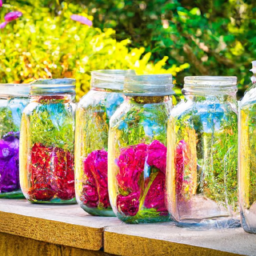
There’s a multitude of innovative ways to repurpose everyday items and reduce waste. Repurposing furniture is one such method that not only reduces landfill space but also gives old pieces a new lease on life. Instead of discarding an old dresser, for example, you can transform it into a unique storage unit by adding shelves or hooks. By repurposing furniture, you not only save money but also contribute to a more sustainable lifestyle.
Another way to reduce waste is by repurposing clothing. Fast fashion has led to an increase in textile waste, but there are several creative ways to give new life to old garments. For instance, you can turn an old t-shirt into a reusable shopping bag or use fabric scraps to create patchwork quilts or pillows. These DIY projects not only minimize waste but also allow you to showcase your creativity and personal style.
Repurposing everyday items not only reduces waste but also promotes resourcefulness and encourages sustainable practices. By utilizing what we already have instead of constantly buying new things, we can significantly reduce our carbon footprint and contribute positively towards the environment.
Recycling Hacks for a Greener Home
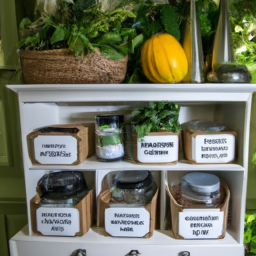
Transform your home into a greener space with these simple recycling hacks. By implementing these tips, you can contribute to the reduction of waste and make a positive impact on the environment.
Green Cleaning: Opt for eco-friendly cleaning products that are made from natural ingredients and come in recyclable packaging. These products not only reduce harmful chemicals in your home but also minimize plastic waste. Look for labels such as "biodegradable," "phosphate-free," or "plant-based" to ensure you’re making a sustainable choice.
Composting Tips: Start composting organic kitchen waste, such as fruit peels, vegetable scraps, and coffee grounds. Composting not only diverts waste from landfills but also produces nutrient-rich soil for your garden. Create a designated compost area in your backyard or use a small bin with an air-tight lid for indoor composting. Remember to turn the compost regularly and maintain the right balance of green (nitrogen-rich) and brown (carbon-rich) materials.
Reduce, Reuse, Recycle: Minimize waste by following the three R’s: Reduce, Reuse, Recycle. Instead of buying single-use items like plastic water bottles or disposable cutlery, invest in reusable alternatives such as stainless steel bottles or bamboo utensils. When it comes to recycling, familiarize yourself with your local recycling guidelines to ensure proper sorting and disposal of recyclable materials.
Upcycling Ideas to Give New Life to Old Objects
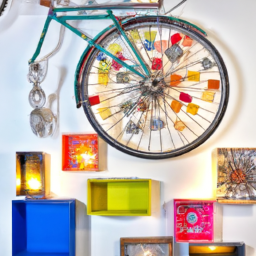
Embrace upcycling to breathe new life into old objects and give them a fresh purpose in your home. Repurposing furniture and following recycled fashion trends not only helps reduce waste but also allows you to tap into your creativity while making a positive impact on the environment.
When it comes to repurposing furniture, the possibilities are endless. Old dressers can be transformed into stylish bathroom vanities or storage units for your living room. By simply adding a fresh coat of paint and some new hardware, you can completely transform an outdated piece of furniture into a unique statement piece for your home.
In addition to repurposing furniture, recycled fashion trends have gained popularity in recent years. Instead of throwing away old clothes, consider giving them a second life by turning them into something new. For example, you could cut up old t-shirts and create a colorful quilt or use denim from old jeans to make trendy tote bags.
Not only does upcycling save money by reducing the need to buy new items, but it also helps reduce the amount of waste that ends up in landfills. According to the Environmental Protection Agency (EPA), approximately 17 million tons of textiles were generated in 2018 alone, with only about 15% being recycled. By embracing upcycling and incorporating recycled fashion trends into your daily life, you can help contribute to a more sustainable future.
Creative DIY Projects for Recycling Enthusiasts
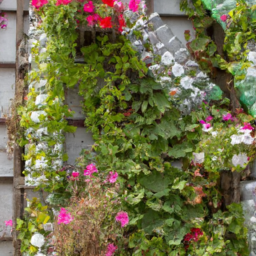
Why not try your hand at some fun and budget-friendly DIY projects that will make use of old materials and give them a new purpose? DIY repurposing is a great way to reduce waste and create unique recycled home decor items. Here are three creative ideas to get you started:
Wine Bottle Vases: Instead of throwing away empty wine bottles, turn them into beautiful vases. Simply clean the bottles thoroughly, remove any labels, and paint them in your desired color or design. You can also add embellishments like twine or ribbon for extra flair. Fill the vases with fresh flowers or even use them as candle holders for an elegant touch.
Pallet Furniture: Old wooden pallets can be transformed into stylish furniture pieces for your home or garden. Sand down the rough edges, paint or stain the pallets to match your decor, and stack them together to create unique coffee tables, bookshelves, or outdoor seating areas. With a little creativity, you can customize these pallets to suit your personal style.
Tire Planters: Give old tires a new lease on life by turning them into planters for your garden or balcony. Clean the tires thoroughly and paint them in vibrant colors that complement your outdoor space. Fill each tire with soil and plant flowers or herbs of your choice. Stack multiple tires on top of each other to create a vertical garden display.
Eco-Friendly Crafts Using Recycled Materials
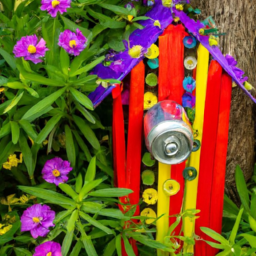
Are you looking for some eco-friendly crafts that utilize recycled materials in creative ways? If so, you’ve come to the right place! Repurposing old items not only reduces waste but also allows you to create unique and stylish pieces for your home or wardrobe. From repurposed fashion to recycled home decor, there are countless possibilities when it comes to crafting with recycled materials.
When it comes to repurposed fashion, one popular idea is turning old t-shirts into trendy tote bags. Simply cut off the sleeves and neckline of the shirt, sew the bottom shut, and attach straps made from leftover fabric or even old belts. This not only gives new life to an old shirt but also provides a functional accessory for carrying your belongings.
For recycled home decor, consider using empty glass jars as vases or candle holders. You can paint them in vibrant colors or wrap them in twine for a rustic look. Old wooden pallets can be transformed into unique shelves or coffee tables by sanding them down and adding a fresh coat of paint.
Another creative idea for repurposing is transforming wine corks into coasters or trivets. By gluing together multiple corks in a desired pattern and sealing them with varnish, you’ll have an eco-friendly alternative to store-bought options.
These are just a few examples of how you can incorporate repurposed fashion and recycled home decor into your life. The possibilities are endless when it comes to recycling materials and turning them into something beautiful and useful. So go ahead, get creative, and start reducing waste while creating one-of-a-kind crafts!
Sustainable Solutions for Reducing Household Waste
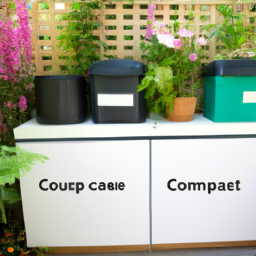
One easy way to cut back on household waste is by composting food scraps and yard waste. Composting is a sustainable method that helps reduce the amount of waste that ends up in landfills while also providing nutrient-rich soil for gardening. Here are three composting methods you can try at home:
Backyard Composting: This traditional method involves creating a pile or bin in your backyard where you can deposit organic materials such as fruit and vegetable scraps, coffee grounds, leaves, and grass clippings. These materials break down over time with the help of microorganisms, turning into dark, crumbly compost.
Vermicomposting: If you have limited space or live in an apartment, vermicomposting is a great option. It involves using worms (typically red wigglers) to break down organic matter. You can keep them in a worm bin or even indoors under controlled conditions. The worms eat the food scraps and produce nutrient-rich castings (worm poop) that can be used as fertilizer.
Bokashi Composting: Bokashi composting is an anaerobic fermentation process that utilizes beneficial microbes to break down food waste quickly. It involves layering food scraps with a special bokashi bran that accelerates the decomposition process. This method works well for small spaces and can handle almost all types of kitchen waste, including meat and dairy products.
In addition to composting methods, another way to reduce household waste is by opting for sustainable packaging options when shopping for groceries or other goods. Look for products packaged in materials like glass, paperboard, or biodegradable plastics instead of single-use plastic containers or wrappers.
Transforming Trash Into Treasure: Recycling Inspiring Art

You can transform everyday trash into inspiring art by repurposing materials and using your creativity. Trash to treasure sculptures and recycled art installations are prime examples of how waste can be turned into something beautiful and thought-provoking. These unique forms of art not only showcase the potential of discarded items but also serve as a reminder of the importance of recycling.
Recycled art installations have gained popularity in recent years due to their ability to raise awareness about environmental issues. Artists around the world have taken up the challenge of transforming waste into captivating pieces that command attention. Through these installations, they encourage viewers to reflect on their own consumption patterns and reconsider what they consider to be valuable.
One remarkable example is the "Plastic Bag Mandala" created by artist Subodh Kerkar. This installation features thousands of discarded plastic bags meticulously arranged in a circular pattern, resembling a traditional mandala. The piece highlights the detrimental effects of single-use plastics on our environment while showcasing the beauty that can arise from reimagining waste.
Another inspiring artist is Michelle Reader, who specializes in creating trash to treasure sculptures using various discarded materials such as metal scraps, old electronics, and even plastic bottles. Her works convey messages about consumerism, sustainability, and human impact on nature. By giving new life to these abandoned objects, she challenges us to see beyond their initial purpose and appreciate them as artistic creations.
Recycling inspiring art not only reduces waste but also sparks conversations about our throwaway culture and its consequences for the planet. It serves as a powerful reminder that with a little imagination and resourcefulness, we can all play a part in making positive change for our environment. So next time you’re disposing of an item, think twice – it could be transformed into something extraordinary through your own creative touch!
Smart Recycling Strategies for a Sustainable Future

Smart recycling strategies can help pave the way towards a more sustainable future. By implementing these strategies, we can effectively manage waste and reduce our environmental impact. Here are three key ways to optimize smart waste management and promote sustainable packaging:
Implementing source separation: Separating recyclable materials at the source is essential for efficient recycling. Encouraging individuals and businesses to sort their waste into separate bins for plastics, paper, glass, and metals ensures that these valuable resources can be easily identified and processed appropriately. This practice significantly reduces contamination rates in recycling streams, improving overall recycling efficiency.
Promoting circular economy principles: Embracing the concept of a circular economy means designing products with end-of-life considerations in mind. This involves using materials that are easily recyclable or compostable, minimizing single-use packaging, and encouraging product repairability or reusability. By closing the loop through responsible consumption and production practices, we can minimize waste generation while conserving natural resources.
Investing in advanced recycling technologies: Advancements in recycling technologies offer exciting opportunities to enhance our waste management systems. Innovations such as chemical recycling and mechanical sorting techniques enable us to recover valuable materials from complex waste streams that were previously challenging to recycle efficiently. Investing in research and development of these technologies can revolutionize our approach to managing waste while reducing our dependence on virgin resources.
Frequently Asked Questions
How Can I Repurpose Everyday Items in Unique and Innovative Ways?
To repurpose everyday items in unique and innovative ways, you can tap into the power of recycling and sustainable living. By thinking outside the box, you can find creative ways to upcycle household items. From turning old jars into stylish storage containers to transforming wine corks into bulletin board pins, there are endless possibilities. Embracing this mindset not only reduces waste but also encourages a more eco-friendly lifestyle. Get ready to unleash your creativity and make a positive impact on the environment!
What Are Some Simple Hacks for Recycling at Home and Making My Household Greener?
To organize your recycling system effectively, start by setting up designated bins for different types of recyclables like paper, plastic, and glass. Clearly label each bin to avoid confusion. Additionally, create a schedule for regular collection and ensure that the items are properly sorted before placing them in the bins. As for eco-friendly alternatives to single-use household items, consider using reusable shopping bags instead of plastic ones, stainless steel straws instead of plastic ones, and cloth napkins instead of disposable ones.
How Can I Give New Life to Old Objects Through Upcycling?
To give new life to old objects through upcycling, you can employ various repurposing techniques. By transforming unused items into sustainable home decor, you not only reduce waste but also create unique and eco-friendly pieces. Upcycling involves creativity and resourcefulness, allowing you to think outside the box and find innovative ways to reuse materials. With a little imagination and some basic tools, you can turn discarded items into stylish and functional additions to your living space.
What Are Some Creative DIY Projects That Recycling Enthusiasts Can Try?
Looking to get creative with your recycling efforts? There are plenty of DIY projects using recycled materials that you can try. From turning old glass bottles into beautiful vases, to transforming wooden pallets into unique furniture pieces, the possibilities are endless. Get those creative juices flowing and start exploring the world of upcycling. Not only will you reduce waste, but you’ll also create something truly one-of-a-kind. So grab your tools and let’s get started on some amazing, creative upcycling ideas!
Are There Any Eco-Friendly Crafts That Use Recycled Materials and Are Easy to Make at Home?
There are plenty of eco-friendly crafts that use recycled materials and can be easily made at home. These crafts not only reduce waste but also provide an opportunity to get creative and have fun. You can try making things like bottle cap magnets, tin can planters, or newspaper baskets. By repurposing items that would otherwise end up in the landfill, you are contributing to a more sustainable future while showcasing your artistic skills.
Conclusion
In conclusion, recycling holds immense power in reducing waste and preserving the environment. By repurposing everyday items, implementing recycling hacks, and embracing upcycling ideas, we can give new life to old objects and contribute to a greener home. Engaging in creative DIY projects using recycled materials and exploring eco-friendly crafts further promotes sustainability. Transforming trash into inspiring art showcases the potential of recycling. By adopting smart recycling strategies, we can work towards a sustainable future where waste is minimized, resources are conserved, and our planet thrives.